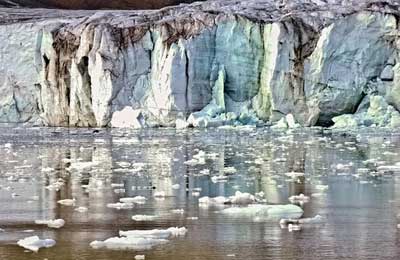
Climate changing before our eyes says WMO
Doha, November 28, 2012
The fact that Arctic sea ice has melted this year to its lowest recorded level shows, along with other weather extremes, that "climate change is taking place before our eyes", the World Meteorological Organization (WMO) said on Wednesday.
The first 10 months of 2012 were the ninth-warmest since records began in the mid-19th century, with early months cooled by a "La Nina" weather event in the Pacific, according to the report, issued at global climate change talks in Doha.
Many regions have faced extremes of droughts, floods and heatwaves. The number of cyclones worldwide was around normal but some, such as Superstorm Sandy, which lashed the Caribbean and the United States, were especially devastating, the WMO said.
"The extent of Arctic sea ice reached a new record low. The alarming rate of its melt this year highlighted the far-reaching changes taking place on Earth's oceans and biosphere," said Michel Jarraud, head of the Geneva-based WMO.
"Climate change is taking place before our eyes and will continue to do so as a result of the concentrations of greenhouse gases in the atmosphere, which have risen constantly and again reached new records," he added in a statement.
Natural cooling events such as La Nina "do not alter the underlying long-term trend of rising temperatures due to climate change as a result of human activities," he said.
The WMO is an agency of the United Nations and has a membership of 190 member states and territories.
GREENHOUSE GASES
He said climate change will continue "as a result of the concentrations of greenhouse gases in the atmosphere, which have risen constantly and again reached new records."
The report said that the global land and ocean surface temperature for the first nine months of 2012 was about 0.45 degrees Celsius (0.81 Fahrenheit) above the corresponding 1961-1990 average of 14.2 degrees C.
Worldwide, it said that tropical cyclones was near the 1981-2010 average of 85 storms, with a total of 81. Typhoon Sanba which hit the Philippines, Japan and the Korean peninsula was the strongest.
The Atlantic basin had an above-average hurricane season for a third consecutive year, it said. Most notable was Sandy, which hit island nations in the Caribbean and the United States.
High temperatures affected especially North America, southern Europe, western and central Russia and northwestern Asia, it said. Heatwaves hit much of the United States and Europe from March to May.
About 15,000 daily heat records were broken across the United States. Droughts also affected much of the United States and parts of Russia, Europe and China.
"Many parts of western Africa and the Sahel, including Niger and Chad, suffered serious flooding between July and September because of a very active monsoon," it said. – Reuters







